英语被动语态
英语语法被动语态
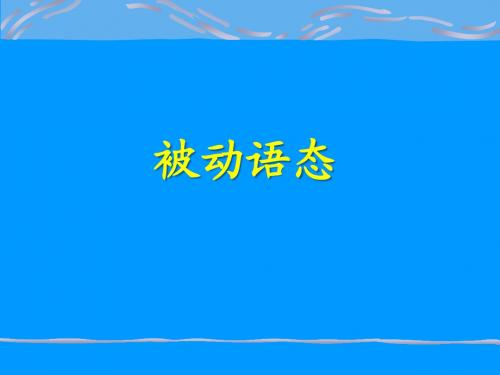
• Trees must be planted in spring. • 树木应该在春天种植 • (没必要说明是谁载的)
B要强调动作的执行者(如果想强调动作 的执行者,用“by+动作的执行者的宾 格”来表示
• The patient was sent to hospital by them. • 那位病人被他们送往医院了
ቤተ መጻሕፍቲ ባይዱ
2、主动句的宾语是each other 或者是 反身代词
The man introduced himself to us. He was introduced by himself . (错)
3、主动句的宾语是不定式或动名词形式 My brother enjoys watching TV. Watching TV is enjoyed by My brother . (错)
• 被动语态的一般疑问形式是将be动词 调到句首 • 由于被动语态的主语是动作的承受者, 相当于主动语态的宾语,因此只有及 物动词才有被动语态; • 不及物动词因为没有动作的对象,故 无被动语态的形式。
二、被动语态的用法
A不知道或者没有必要说明动作的执行者
• The bridge was built 100 years ago. • 这座桥是100年前建造的。 • (不知道是谁建的)
2、look,sound,taste,smell等 系动词用主动语态表示被动语态。 The food tastes delicious.
3、be worth doing sth 值得做某事 主动表示被动意义 The book is worth reading. 这本书值得一读
例句:主动语态变被动语态的方法
We use a recorder in our English class.
英语语法被动语态总结
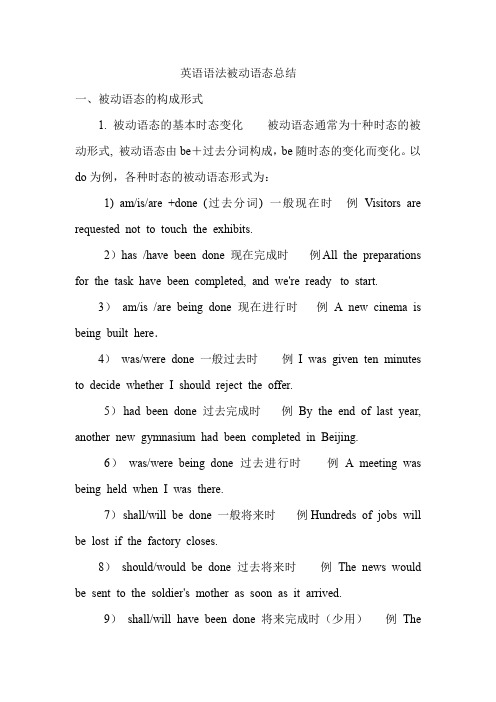
英语语法被动语态总结一、被动语态的构成形式1. 被动语态的基本时态变化被动语态通常为十种时态的被动形式, 被动语态由be+过去分词构成,be随时态的变化而变化。
以do为例,各种时态的被动语态形式为:1) am/is/are +done (过去分词) 一般现在时例Visitors are requested not to touch the exhibits.2)has /have been done 现在完成时例All the preparations for the task have been completed, and we're ready to start.3)am/is /are being done 现在进行时例 A new cinema is being built here.4)was/were done 一般过去时例I was given ten minutes to decide whether I should reject the offer.5)had been done 过去完成时例By the end of last year, another new gymnasium had been completed in Beijing.6)was/were being done 过去进行时例 A meeting was being held when I was there.7)shall/will be done 一般将来时例Hundreds of jobs will be lost if the factory closes.8)should/would be done 过去将来时例The news would be sent to the soldier's mother as soon as it arrived.9)shall/will have been done 将来完成时(少用)例Theproject will have been completed before July.2. 被动语态的特殊结构形式1)带情态动词的被动结构。
英语语法结构——被动语态
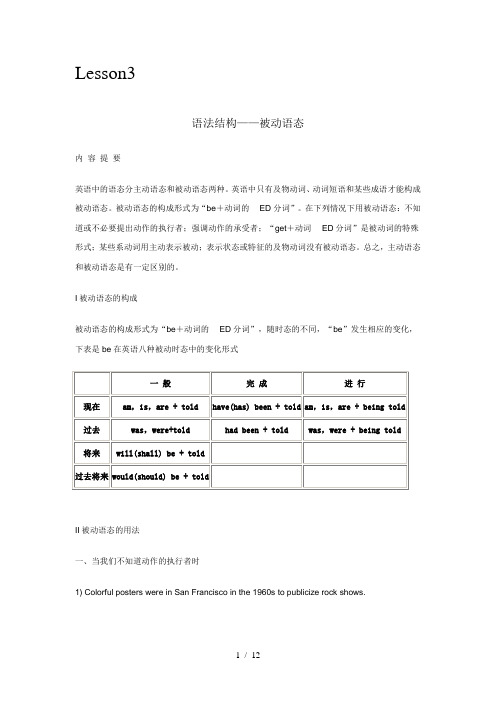
Lesson3语法结构——被动语态内容提要英语中的语态分主动语态和被动语态两种。
英语中只有及物动词、动词短语和某些成语才能构成被动语态。
被动语态的构成形式为“be+动词的ED分词”。
在下列情况下用被动语态:不知道或不必要提出动作的执行者;强调动作的承受者;“get+动词ED分词”是被动词的特殊形式;某些系动词用主动表示被动;表示状态或特征的及物动词没有被动语态。
总之,主动语态和被动语态是有一定区别的。
I被动语态的构成被动语态的构成形式为“be+动词的ED分词”,随时态的不同,“be”发生相应的变化,下表是be在英语八种被动时态中的变化形式一般完成进行现在am,is,are + told have(has) been + told am,is,are + being told 过去was,were+told had been + told was,were + being told 将来will(shall) be + told过去将来would(should) be + toldII被动语态的用法一、当我们不知道动作的执行者时1) Colorful posters were in San Francisco in the 1960s to publicize rock shows.[A]print[B]prints[C]printed[D]printing2) The main [A]stream of a river frequently is dividing [B]into two or more [C]branches near its mouth [D] .二、当我们不必要指出动作的执行者时3) The tenor drum(小鼓) is used primarily in military bands and is normally with small felt sticks.[A]play[B]played[C]to play[D]playing4) I’ll take down your name and address in case you as a witness.[A]are needed[B]will be needed[C]need[D]will need5) Cottage cheese,an American favorite [A],can made easily [B]at home [C]from milk [D],lemon,juice,and salt.三、当我们强调或侧重动作的承受者时,这时我们通常用by引出动作的执行者6) The seating of musicians in an orchestra is arranged to produce the desired blend of sounds from the various musical sections.A the conductor ofB from the conductorC the conductor andD by the conductor7) The bridge was hitting [A]by a large ship during [B]a sudden [C]storm last [D]week.四、“get+ed分词”的被动语态,这时习惯固定用法,这种结构往往更强调动作的结果而非动作的本身8) “Your daughter has two children, doesn’t she?”“That’s right. She in 1970.”[A]did marriage[B]was married[C]had married[D]got married9) Supposing you five bottles of beer, do you think you would get drunk?[A]were drinking[B]have drunk[C]were to drink[D]drink五、主动形式表示被动意义,如某些系动词如cook, feel, prove, smell和taste等其主动语态表示被动的意义10) The patted shoes that my wife bought me comfortable.[A]felt[B]feels[C]was felt[D]is felt11) As [A]the proverb says [B], “Good medicine is tasted [C]bitter to [D]the mouth.”六、没有被动语态的词,表示状态或特征的及物动词如contain, cost, fit, have, lack, suit等没有被动形式,另外,诸如happen, occur, take place, break out 等不及物动词或短语以及诸如result from(缘于),belong to, consist of等只用主动语态,而不用被动语态12) Some critics maintain that when [A]a work of literature is lacked [B]reference to [C]the general experience of mankind,it fails as art [D] .13) The book that I bought [A]the day before [B]yesterday is costed [C]me twenty and a half yuan [D] .[注]除此之外,某些词如反身代词和相互代词以及ING和不定式不能作为被动语态的主语;某些被动语态没有相应的主动语态如“I was born in 1966.”。
初中英语语法被动语态

动词的语态
1.英语中动词有两种语态: 主动语态表示主语是谓语动词的执行者。 被动语态表示主语是谓语动作的承受者。例如:A talk on science will be given in our school next Monday.下周一在我们学校将会有一场关于科学的演讲。
B. will finish
C. will be finished D. would finish
过去将来时态:would + be+过去分词
6、The old scientist said that he ______ to visit their country
before long .
A. invited
B. had invited
C. was inviting D. would be invited
现在完成时态:have/has + been +过去分词
7、With the help of the Hope Project, more and more new schools _____
in the poor area.
在被动语态中,主语是动作的承受者,主要用于下列几种情况 中:
(1)不知道动作的执行者是谁。 This watch is made in China.这块手表是在中国制造的。 (2)没有必要指出动作的执行者是谁。 More trees must be planted every year.每年都应该种更多 的树。
6 过去进行时 was/were+现在分词
was/were+being+过去分词
7 现在完成时 8 过去完成时 9 含情态动词
初中英语被动语态

D. have used
( )6.The windows of our house _____once a week. A. must clean B. have cleaned C. is cleaned D. are cleaned
( )7. To make our city more beautiful, rubbish ____ into the river. A.needn’t be thrown B. mustn’t be thrown C. can’t throw D. may not throw
英语初中被动语态
• 一、动词有两种语态:主动语态和被动语态。主 动语态表示主语是谓语动作的执行者;被动语态 则表示主语是谓语动作的承受者。
• 二、被动语态的构成 • 基本结构是: • “助动词be+及物动词的过去分词”。
各种时态被动语态的结构
被动语态的时态、人称和数的变化 主要体现在be的变化上,其形式与系动词be的变化形式完全一 样。 不同时态的被动语态,列表如下: 一般现在时:am / is / are + done 一般过去时:was / were + done 一般将来时:shall / will + be done 一般过去将来时:should / would + be done 现在进行时:am / is / are + being + done 过去进行时:was / were + being + done 现在完成时:have / has + been + done 过去完成时:had + been + done 将来完成时:shall / will + have been + done 过去将来完成时:should / would + have been + done [注]被动语态没有将来进行时和过去将来进行时。
英语10种被动语态用法
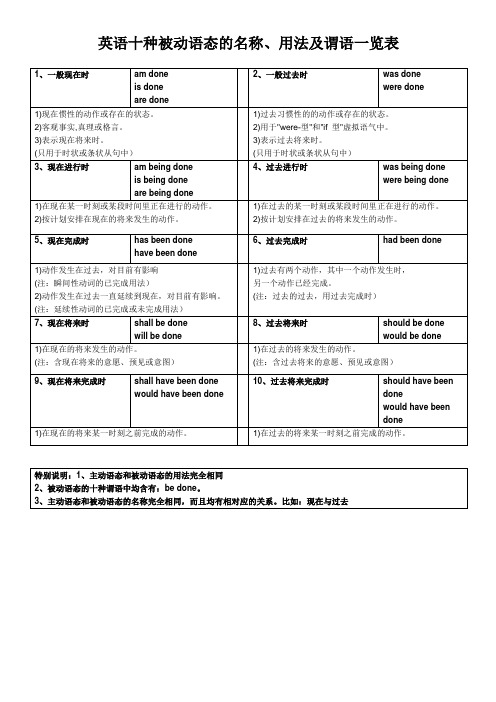
3、主动语态和被动语态的名称完全相同,而且均有相对应的关系。比如:现在与过去
3)表示过去行时
am being done
is being done
are being done
4、过去进行时
was being done
were being done
1)在现在某一时刻或某段时间里正在进行的动作。
2)按计划安排在现在的将来发生的动作。
1)在过去的某一时刻或某段时间里正在进行的动作。
2)按计划安排在过去的将来发生的动作。
5、现在完成时
has been done
have been done
6、过去完成时
had been done
1)动作发生在过去,对目前有影响
(注:瞬间性动词的已完成用法)
2)动作发生在过去一直延续到现在,对目前有影响。
(注:延续性动词的已完成或未完成用法)
1)过去有两个动作,其中一个动作发生时,
9、现在将来完成时
shall have been done
would have been done
10、过去将来完成时
should have been done
would have been done
1)在现在的将来某一时刻之前完成的动作。
1)在过去的将来某一时刻之前完成的动作。
特别说明:1、主动语态和被动语态的用法完全相同
另一个动作已经完成。
(注:过去的过去,用过去完成时)
7、现在将来时
shall be done
will be done
8、过去将来时
should be done
would be done
被动语态 英语有两种语态

被动语态英语有两种语态:主动语态和被动语态主动语态(The Active V oice)表示主语是动作的执行者。
被动语态(The Passive V oice)表示主语是动作的承受者。
构成:承受者+助动词be+及物动词的过去分词+by+执行者一般现在时:承受者+助动词am / is/are +及物动词的过去分词+by+执行者一般过去时:承受者+助动词was / were +及物动词的过去分词+by+执行者承受者+助动词shall / will be+及物动词的过去分词+by+执行者承受者+助动词have/ has been+及物动词的过去分词+by+执行者承受者+ can /may/must/should +be+及物动词的过去分词+by+执行者被动语态用法:1)当我们不知道动作的执行者是谁,或者没有必要指出动作的执行者时,需用被动语态。
2)当我们需要强调动作的承受者时,常用被动语态。
3)如果需要说出动作的执行者, 用by引导出动作的执行者。
主动语态变为被动语态时,其谓语动词的时态要与原句时态保持一致,其谓语动词的数要与新主语保持一致。
主动语态变为被动语态时有以下几种情况:1)主语+谓语动词+宾语将主动语态的宾语变为被动语态的主语。
(主动)We bought a book yesterday. (被动)The book was bought yesterday. 2)主语+谓语动词+间接宾语+直接宾语将主动语态中一个宾语变为被动语态的主语。
多数情况下将间接宾语变为主语。
如果直接宾语变为主语时,间接宾语前要加介词to / for。
(主动)He showed me a book yesterday. (被动)I was showed a book yesterday. (被动)The book was showed to me yesterday. 3)主语+谓语动词+复合宾语含有一个由宾语加宾语补足语构成的复合宾语,变为被动语态时,将主动语态的宾语变为被动语态的主语,宾语补足语保留不变,成为主语补足语。
英语被动语态总结
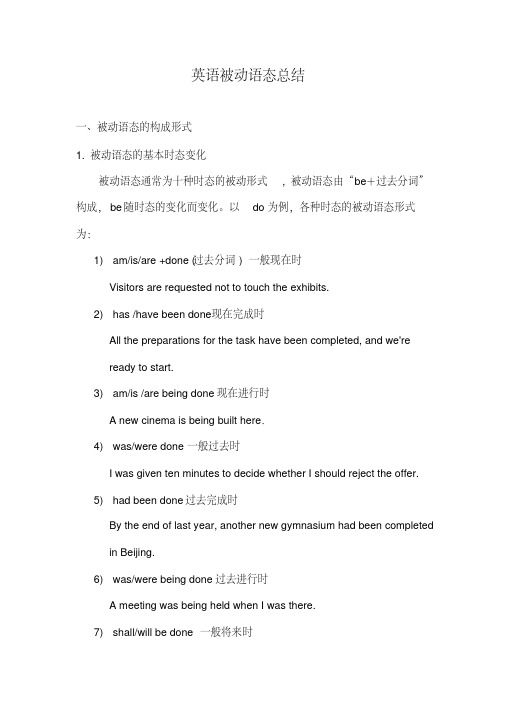
英语被动语态总结一、被动语态的构成形式1. 被动语态的基本时态变化被动语态通常为十种时态的被动形式, 被动语态由“be+过去分词”构成,be随时态的变化而变化。
以do为例,各种时态的被动语态形式为:1)am/is/are +done (过去分词) 一般现在时Visitors are requested not to touch the exhibits.2)has /have been done 现在完成时All the preparations for the task have been completed, and we'reready to start.3)am/is /are being done 现在进行时A new cinema is being built here.4)was/were done 一般过去时I was given ten minutes to decide whether I should reject the offer.5)had been done 过去完成时By the end of last year, another new gymnasium had been completed in Beijing.6)was/were being done 过去进行时A meeting was being held when I was there.7)shall/will be done 一般将来时Hundreds of jobs will be lost if the factory closes.8)should/would be done 过去将来时The news would be sent to the soldier's mother as soon as it arrived.9)shall/will have been done 将来完成时(少用)The project will have been completed before July.10)should/would have been done 过去将来完成时(少用)He told me that his new clothes would have been made very soon. 2. 被动语态的特殊结构形式1)带情态动词的被动结构。
英语被动语态的结构
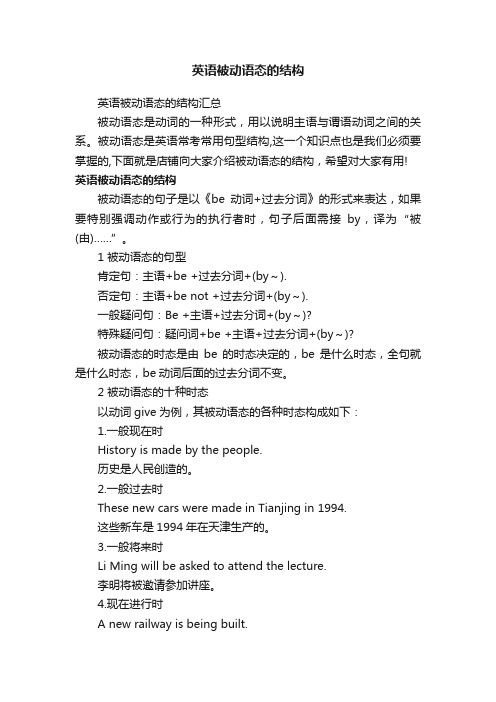
英语被动语态的结构英语被动语态的结构汇总被动语态是动词的一种形式,用以说明主语与谓语动词之间的关系。
被动语态是英语常考常用句型结构,这一个知识点也是我们必须要掌握的,下面就是店铺向大家介绍被动语态的结构,希望对大家有用! 英语被动语态的结构被动语态的句子是以《be动词+过去分词》的形式来表达,如果要特别强调动作或行为的执行者时,句子后面需接by,译为“被(由)……”。
1 被动语态的句型肯定句:主语+be +过去分词+(by~).否定句:主语+be not +过去分词+(by~).一般疑问句:Be +主语+过去分词+(by~)?特殊疑问句:疑问词+be +主语+过去分词+(by~)?被动语态的时态是由be的时态决定的,be是什么时态,全句就是什么时态,be动词后面的过去分词不变。
2 被动语态的十种时态以动词give为例,其被动语态的各种时态构成如下:1.一般现在时History is made by the people.历史是人民创造的。
2.一般过去时These new cars were made in Tianjing in 1994.这些新车是1994年在天津生产的。
3.一般将来时Li Ming will be asked to attend the lecture.李明将被邀请参加讲座。
4.现在进行时A new railway is being built.一条新铁路正在修建。
5.过去进行时The roads were being widened.路那时正在加宽。
6.现在完成时He has been sent to work in Shanghai.他已经被派往去上海工作了。
7.过去完成时A new hotel had been built when I got there.我到那儿时,一座新旅馆已经建好了。
8.过去将来时He said a new hotel would be built in two months.他说两个月后新旅馆就会建好了的。
英语被动语态

英语被动语态被动语态,即不知道动作执行者或强调动作承受者的一种语态。
英语的语态是通过动词形式的变化表现出来的。
英语中有两种语态:主动语态和被动语态。
主动语态表示主语是动作的执行者。
被动语态表示主语是动作的承受者,即行为动作的对象。
主动语态变为被动的几个特殊情况① 有些动词在主动结构中,后面接不带to的不定式,但如果改为被动,则需把省略的to加上,这类动词有 [let, make, have,help]和感官动词[feel,see,hear,watch,look at,listen to],如:The boss made my grandfather work 10hours a day.改成My grandfather was made to work for 10 hours a day.② 含有宾语从句的主动结构变为被动,通常用it作为被动结构的先行主语,从句放在句子后面/也可采用另一种形式,这类动词有:know, say, believe, find, think, report等③ 不是所有的主动句都可以变换成被动句,更不是所有的被动句都可以自由变换成主动句。
虽然语法原则上允许主动和被动句的互相转换,但有的句子转换后会变成不通顺或不地道的英语句子。
因此,在某些题目里,这也成为判断应该用主动还是用被动的依据。
例:At 5:05 p.m. on Saturday 19th July , there was an accident at the junction of the Main Street and Panda Road when a boy was knocked down off his bicycle by a delivery van. The boy was sent to St. Maria Hospital where he was treated for shock and a broken arm.在这段文章里,a boy was knocked down off his bicycle by a delivery van这句被动句强调出读到文章的人最关心的事故的受害者。
被动语态(讲解)

被动语态1:英语中语态有两种:主动语态和被动语态。
语态的作⽤:语态是动词的⼀种形式,⽤来说明主语和谓语之间的关系。
语态的选⽤:如果主语是动作的执⾏者,谓语⽤主动语态。
例如:We clean the room every day.如果主语是动作的承受者,或者说是动作的对象,谓语则是要⽤被动语态。
例如:The room is cleaned every day.2:被动语态的各种形式1) am/is/are +doneeg:I'm asked to take care of myself.eg:Football is played all over the world.2)has /have been doneeg:This book has been translated into many foreign languages.eg:The prices of many goods have been cut again .3)am/is /are being doneeg:A road is being built around the mountain.eg:Many new houses are being built in this city.4) was/were doneeg1:This house was built in 1958.eg2:His leg was broken in an accident.5) had been doneeg1:A new school had been set up by the end of last year.eg2:When the anthem had been played the conference began.6) was/were being doneeg1: meeting was being held when I was there.eg2:We were being trained this time last year.7) shall/will be doneeg1:More factories will be built in our city.eg2:He will be taken to hospital tomorrow.8) shall/will have been doneeg1:The project will have been completed before July.eg2:Your clothes shall have been made for you soon.9) should/would be doneeg1:He told me that his new cloths would be made by his mother.10) should/would have been doneeg1:He told me that his new clothes would have been made very soon.3:主动形式表⽰被动意义1)及物动词的不及物⽤法:主语通常是物,且有着某种内在的特点。
英语被动语态表
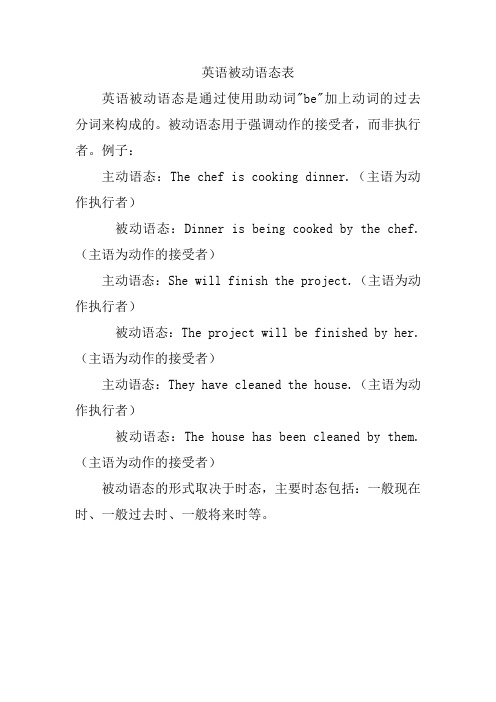
英语被动语态表
英语被动语态是通过使用助动词"be"加上动词的过去分词来构成的。
被动语态用于强调动作的接受者,而非执行者。
例子:
主动语态:The chef is cooking dinner.(主语为动作执行者)
被动语态:Dinner is being cooked by the chef.(主语为动作的接受者)
主动语态:She will finish the project.(主语为动作执行者)
被动语态:The project will be finished by her.(主语为动作的接受者)
主动语态:They have cleaned the house.(主语为动作执行者)
被动语态:The house has been cleaned by them.(主语为动作的接受者)
被动语态的形式取决于时态,主要时态包括:一般现在时、一般过去时、一般将来时等。
英语被动语态
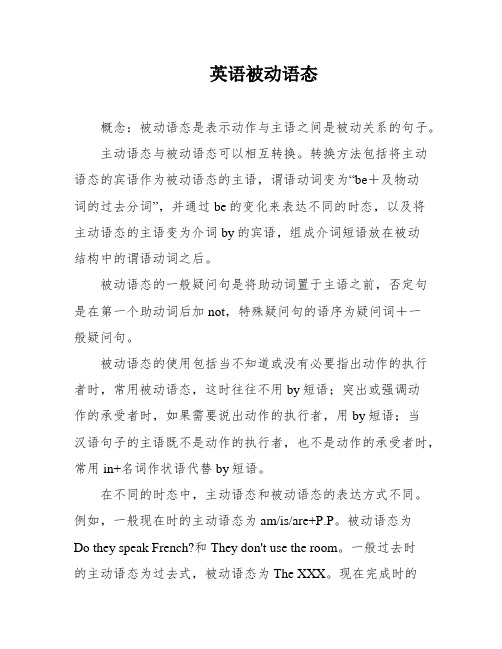
英语被动语态概念:被动语态是表示动作与主语之间是被动关系的句子。
主动语态与被动语态可以相互转换。
转换方法包括将主动语态的宾语作为被动语态的主语,谓语动词变为“be+及物动词的过去分词”,并通过be的变化来表达不同的时态,以及将主动语态的主语变为介词by的宾语,组成介词短语放在被动结构中的谓语动词之后。
被动语态的一般疑问句是将助动词置于主语之前,否定句是在第一个助动词后加not,特殊疑问句的语序为疑问词+一般疑问句。
被动语态的使用包括当不知道或没有必要指出动作的执行者时,常用被动语态,这时往往不用by短语;突出或强调动作的承受者时,如果需要说出动作的执行者,用by短语;当汉语句子的主语既不是动作的执行者,也不是动作的承受者时,常用in+名词作状语代替by短语。
在不同的时态中,主动语态和被动语态的表达方式不同。
例如,一般现在时的主动语态为am/is/are+P.P。
被动语态为Do they speak French?和They don't use the room。
一般过去时的主动语态为过去式,被动语态为The XXX。
现在完成时的主动语态为have/has+P.P。
被动语态为Have they been invitedto the party?和The book has been read by many people.A XXX XXX last year。
French is spoken by them。
The room is not used by them。
A new bridge is being built。
He isXXX the plan at that time。
She has learned many English words。
He has finished the work。
They have solved the problem。
Wehad told him the news by then。
英语被动语态
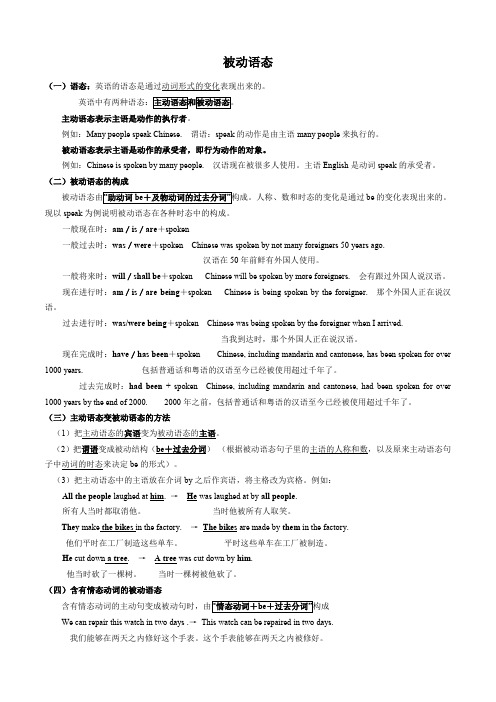
被动语态(一)语态:英语的语态是通过动词形式的变化表现出来的。
英语中有两种语态:主动语态和被动语态。
主动语态表示主语是动作的执行者。
例如:Many people speak Chinese. 谓语:speak的动作是由主语many people来执行的。
被动语态表示主语是动作的承受者,即行为动作的对象。
例如:Chinese is spoken by many people. 汉语现在被很多人使用。
主语English是动词speak的承受者。
(二)被动语态的构成被动语态由“助动词be+及物动词的过去分词”构成。
人称、数和时态的变化是通过be的变化表现出来的。
现以speak为例说明被动语态在各种时态中的构成。
一般现在时:am/is/are+spoken一般过去时:was/were+spoken Chinese was spoken by not many foreigners 50 years ago.汉语在50年前鲜有外国人使用。
一般将来时:will/shall be+spoken Chinese will be spoken by more foreigners. 会有跟过外国人说汉语。
现在进行时:am/is/are being+spoken Chinese is being spoken by the foreigner. 那个外国人正在说汉语。
过去进行时:was/were being+spoken Chinese was being spoken by the foreigner when I arrived.当我到达时,那个外国人正在说汉语。
现在完成时:have/has been+spoken Chinese, including mandarin and cantonese, has been spoken for over 1000 years. 包括普通话和粤语的汉语至今已经被使用超过千年了。
英语被动语态
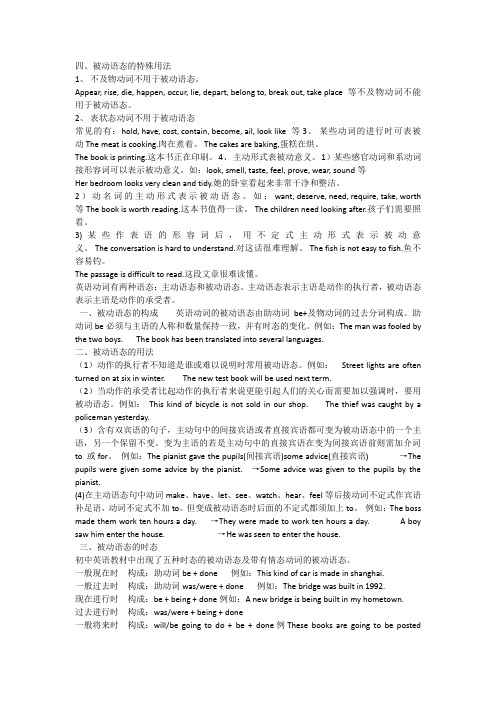
四、被动语态的特殊用法1、不及物动词不用于被动语态。
Appear, rise, die, happen, occur, lie, depart, belong to, break out, take place等不及物动词不能用于被动语态。
2、表状态动词不用于被动语态常见的有:hold, have, cost, contain, become, ail, look like等 3、某些动词的进行时可表被动 The meat is cooking.肉在煮着。
The cakes are baking,蛋糕在烘。
The book is printing.这本书正在印刷。
4、主动形式表被动意义。
1)某些感官动词和系动词接形容词可以表示被动意义。
如:look, smell, taste, feel, prove, wear, sound等Her bedroom looks very clean and tidy.她的卧室看起来非常干净和整洁。
2)动名词的主动形式表示被动语态。
如:want, deserve, need, require, take, worth 等 The book is worth reading.这本书值得一读。
The children need looking after.孩子们需要照看。
3)某些作表语的形容词后,用不定式主动形式表示被动意义。
The conversation is hard to understand.对这话很难理解。
The fish is not easy to fish.鱼不容易钓。
The passage is difficult to read.这段文章很难读懂。
英语动词有两种语态:主动语态和被动语态。
主动语态表示主语是动作的执行者,被动语态表示主语是动作的承受者。
一、被动语态的构成英语动词的被动语态由助动词be+及物动词的过去分词构成。
助动词be必须与主语的人称和数量保持一致,并有时态的变化。
- 1、下载文档前请自行甄别文档内容的完整性,平台不提供额外的编辑、内容补充、找答案等附加服务。
- 2、"仅部分预览"的文档,不可在线预览部分如存在完整性等问题,可反馈申请退款(可完整预览的文档不适用该条件!)。
- 3、如文档侵犯您的权益,请联系客服反馈,我们会尽快为您处理(人工客服工作时间:9:00-18:30)。
英语被动语态一、什么是被动语态?英语中时态很多,但语态不多,只有两种,即:主动语态和被动语态。
所谓“被动语态”,相当于中文中常说的“被……”、“由……”的句式,如:“他的自行车被偷了。
”,“这座楼房是由他们建造的。
”二、被动语态的结构那么,英语中被动语态是怎么样构成的呢?请看下面的例句(注意划线局部):His bicycle was stolen.The building has been built in 2000.通过上面的例句,能够看出,“被动语态”的构成是:be + 过去分词+ (by+动作执行者)三、被动语态的使用什么情况下要用被动语态呢?一般地说,有下面几种情况:(1)不知道谁是动作的执行者或没有必要。
例如:Paper is made from wood. (纸是由木材生产出来的。
)The house is quite old. It was built in 1950. (这座房子太旧了。
它是1950年建成的。
)He was wounded in the fight. (他在战斗在受伤了。
)Electricity is used to run machines. (电是用来开动机器的。
)(2)需要强调动作的对象时。
例如:Calculator can't be used in the maths exam.(计算器不能用于数学考试。
)Books and newspapers in the reading room mustn’t be taken away. (阅览室的书籍和报纸不准带走。
)He was awarded first prize in that contest.(他在比赛中获得了第一。
)(3)为了使语气婉转,避免提到是谁做的这件事。
例如:The construction of the new lab must be completed by the end of next month. (新实验室必须在下个月底前完工。
)四、各种时态的被动语态举例一般地讲,被动语态可用于英语的各种时态。
为了能准确地使用被动语态,重点是要掌握be动词的各种时态变化。
各种时态的被动语态举例如下:1、一般现在时的被动语态. am / is / are + 动词的过去分词Our classroom is cleaned every day.This car is made in China.2、一般过去式的被动语态:was / were + 动词的过去分词His desk was cleaned just now.The station was built in 1928.3、现在实行时的被动语态:am / is / are + being + 动词的过去分词A new factory is being built in our city now.Some trees are being cut down in the park.4、过去实行时的被动语态:was / were + being + 动词的过去分词A new factory was being built in our city at that time.Some babies were being looked after by Miss Chen last year.5、一般将来时的被动语态:(A) will / shall + be + 动词的过去分词(B) am / is / are + going to be +动词的过去分词.Some new factories will be built in our city this year.Your watch is going to be mended in an hour.6、过去将来时的被动语态:(1).would / should + be + 动词的过去分词(2).was / were +going to be + 动词的过去分词.She said that some new factories would be built soon in our city.He thought that your watch was going to be mended after an hour.7、现在完成时的被动语态:have / has + been + 动词的过去分词Some new factories have been built in the city since last year.Your watch has been mended already.8、过去完成时的被动语态:had + been + 动词的过去分词He said that some new factories had been built in the city.I didn’t know that my watch had been mended.9、含情态动词的被动式:can/may/must + be + done例如:He can not be found. / I must be paid for this.五、如何将主动语态变成被动语态1、从句子意义上说,就是重新找出“什么事物”是“被完成”的。
例1.主动语态:人们说英语。
People speak English in many countries.被动语态:英语被说。
English is spoken in many countries..例2.主动语态:我们造这座桥。
We built this bridge last year.被动语态:这座桥被建造。
This bridge was built last year.2、从语法的角度说,把原句的宾语改成主语。
例1.主动语态:小王邀请你(宾语) Xiao Liu has invited you to a lunch party.被动语态:你(宾语)被邀请。
You has been invited to a lunch party by Xiao Wang.例2.主动语态:你不准带走杂志(宾语) You must not take these magazines out of the reading-room.被动语态:杂志(宾语)不准被带走.These magazines must not be taken out of the reading room.例3.主动语态:他们授给他(宾语)一枚奖章(宾语).They gave him a medal for his wonderful work.被动语态:他(宾语)被授予一枚奖章. He was given a medal for his wonderful work.被动语态:一枚奖章(宾语)被授给了他.A medal was given to him for his wonderful work.六、练习1.We shall discuss the problem at tomorrow's meeting.(提示) the problem -be - discuss2.Has anybody fed the birds?(提示) Has anybody - be - feed3.People will never forget the accident.(提示) the accident - will be - forget4.They are repairing the car in the garage.(提示) the car - be being - repair5.Someone must have turned on the light without your notice.(提示) the light - must have - be - turn on6.They have found ways to make waste water clean.7.Someone must take care of the children when we go out.8.They won't hold the meeting until next Friday.9.You may write this letter in pencil.10.They gave him a medal for his wonderful work.被动语态复习ABCA.熟记结构被动语态的结构为“助动词be+及物动词的过去分词(p.p)”。
被动语态的不同时态是通过be的时态变化来表示的,其人称和数方面应与主语保持一致。
其具体变化为:一般现在时:am/is/are+p.p.一般过去时:was/were+p.p.一般将来时:shall /will be +p.p.现在完成时:have /has been +p.p.现在实行时:am/is/are+being+p.p.过去将来时:should /would be +p.p.含情态动词的被动结构:情态动词+be+p.p.例如:①Chinese ______ by the largest number of people.A.speakB.is speakingC.speaksD.is spoken(选D。
考查一般现在时的被动语态)②The boy ______ to get supper ready after school.A.were toldB.is tellingC.was toldD.tells(选C。
考查一般过去时的被动语态)③A lot of new roads ______ built in the west of China.A.mustB.must beC.hasD.have(选B。
考查含情态动词的被动语态)B.明确用法被动语态常用于以下两种情况:1.不知道谁是动作的执行者,或者没有必要指出谁是动作的执行者;2.强调动作的承受者。
例如:这棵树是那个男孩弄断的。
The tree ______ ______ by that boy.。
